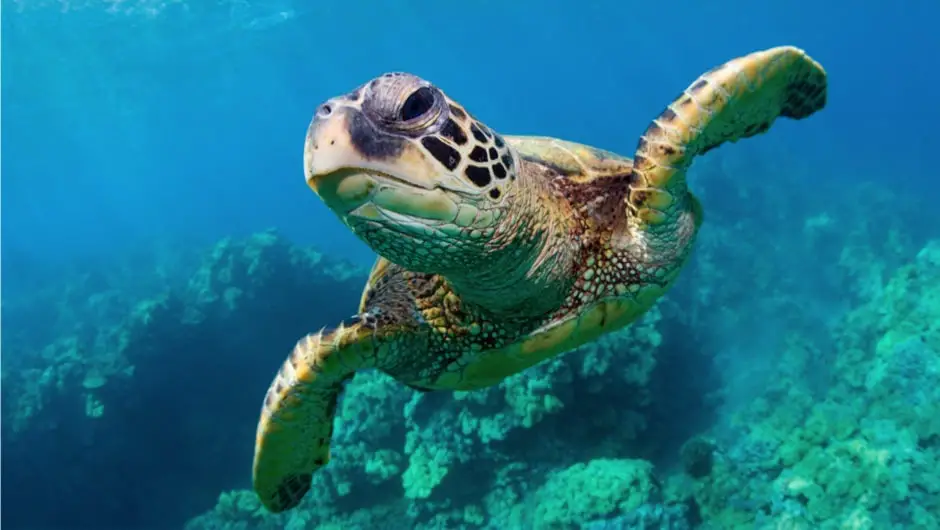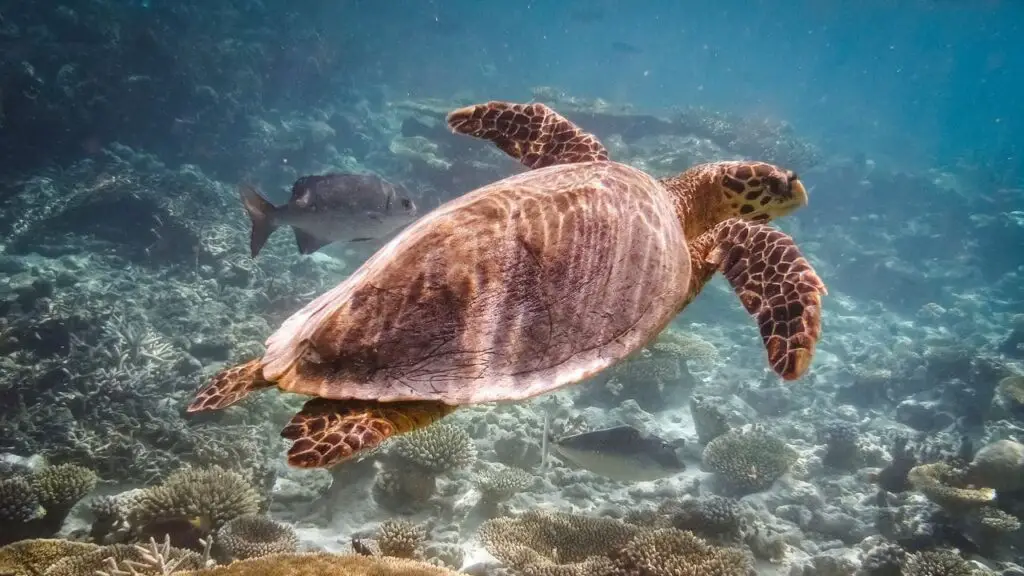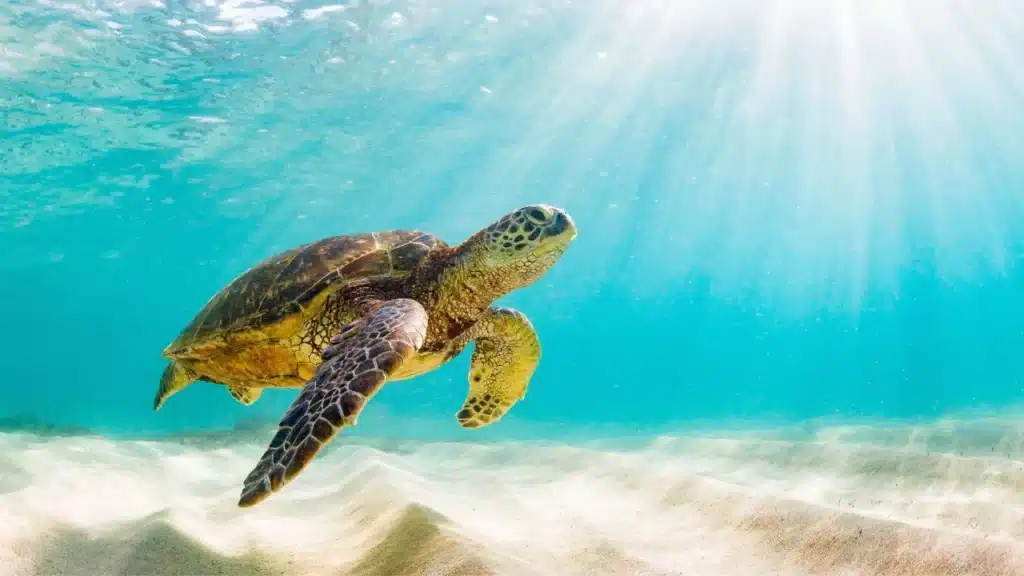How Do Sea Turtles Breathe Underwater

Introduction
How Do Sea Turtles Breathe Underwater: Sea turtles, the ancient mariners of our oceans, have fascinated scientists and nature enthusiasts for centuries. These remarkable creatures have adapted to a life spent predominantly in the water, but they are not fish; they are reptiles, and they need to breathe air. Understanding how sea turtles manage to breathe underwater while spending most of their lives beneath the surface is a testament to the wonders of evolutionary biology and marine adaptation.
The quest to uncover the secrets of sea turtle respiration takes us into the realm of marine biology, where these creatures have evolved a range of fascinating adaptations to thrive in their aquatic environment. Unlike mammals, such as dolphins or whales, which are obligate air breathers and need to surface regularly, sea turtles have a unique way of extracting oxygen from the surrounding water. They have developed an intriguing mechanism that enables them to stay submerged for extended periods, sometimes hours or even days, depending on the species and activity.
In this exploration, we delve into the anatomy, behavior, and remarkable adaptations of sea turtles that allow them to breathe underwater. From their specialized lungs to their efficient use of air, from buoyancy control to the role of their unique cloacal bursae, we will unravel the secrets of how these captivating creatures survive and thrive beneath the waves.

How do turtles stay underwater for so long?
Turtles use cloacal respiration, which involves flowing water over the blood vessel-covered body surfaces, to get oxygen from the water. The phrase cloacal respiration refers to the process of getting oxygen through a turtle’s cloaca, which is essentially its butt and has numerous blood vessels.
Turtles’ ability to stay underwater for extended periods is a marvel of evolutionary adaptation. Unlike mammals that need to surface for air regularly, turtles have developed several strategies to remain submerged.
Firstly, turtles possess specialized lungs that are highly efficient. They can extract a significant amount of oxygen from a single breath, allowing them to prolong their dives. Moreover, their heart rate slows down while underwater, conserving oxygen and reducing the need for frequent respiration.
Secondly, turtles can store oxygen in their muscles and bloodstream. When they take a breath at the surface, they load their muscles with oxygen, acting as a sort of oxygen reserve. As they dive, they gradually deplete this reserve, extending the time they can spend submerged.
Lastly, turtles have adapted their behavior to minimize energy expenditure. They move gracefully and conservatively underwater, relying on slow and deliberate strokes of their flippers. This reduces their oxygen consumption during dives.
These combined adaptations enable turtles to stay underwater for remarkably long periods, with some species capable of remaining submerged for hours or even days. This ability is crucial for their survival, allowing them to forage for food, evade predators, and undertake long migrations across the oceans. It’s a testament to the incredible diversity of life on Earth and the remarkable ways in which species have adapted to their environments.
Do sea turtles have gills or lungs?
Just like other reptiles, sea turtles have lungs. They have a slightly different structure than mammalian lungs, but work just as well when it comes to exchanging gases (oxygen and carbondioxide). The lungs are located right under the carapace and the vertebral column.
Sea turtles, unlike fish, do not have gills. Instead, they are reptiles, and like all reptiles, they breathe air through lungs.
Sea turtles have well-developed lungs that enable them to breathe atmospheric oxygen. When they come to the water’s surface, they take a breath, filling their lungs with air. These breaths are essential for their survival because they supply oxygen to their bloodstream.
What makes sea turtles fascinating is their ability to extract oxygen from the air during their brief visits to the surface and then efficiently utilize that oxygen during extended dives underwater.
They have evolved specialized adaptations, including the ability to slow their heart rate, which reduces their oxygen consumption, and the capacity to store oxygen in their muscles and bloodstream. These adaptations allow them to remain submerged for varying durations, depending on the species and activity, while still relying on their lungs for respiration.
Do turtles sleep in the water?
Aquatic turtles may spend hours sleeping on a dry dock or with their head poking out of the water but they may also sleep underwater for shorter periods of time, coming up to take a breath when necessary. Land turtles don’t swim like aquatic turtles so they can sleep anytime, anywhere.
Turtles do sleep in the water, and their sleep patterns are a fascinating aspect of their biology. While they are primarily aquatic creatures, turtles must surface to breathe because, unlike fish, they have lungs and are air-breathers. This necessity to breathe has led to some interesting adaptations in their sleep behavior.
Turtles can sleep underwater, but it’s not the same as the deep, uninterrupted sleep that humans experience. Instead, they enter a state called “resting behavior” or “dormancy.” During this time, turtles become less active, and their metabolic rate decreases. They may find a secluded spot, such as a protected nook or a safe underwater crevice, to rest.
Even while resting underwater, turtles remain partially aware of their surroundings, allowing them to come up for air when needed. This heightened state of awareness is crucial for their survival, as it helps them avoid potential threats like predators and disturbances in their environment.
Some species of turtles, like the loggerhead sea turtle, have been observed resting at the bottom of the ocean for hours. This behavior demonstrates their remarkable ability to adapt to their semi-aquatic lives, balancing the need for rest with the necessity to breathe, ensuring their continued survival in the dynamic underwater world.
How long can a sea turtle stay underwater without breathing?
When they are active, sea turtles must swim to the ocean surface to breathe every few minutes. When they are resting, they can remain underwater for as long as 2 hours without breathing.
Sea turtles are renowned for their impressive breath-holding abilities, allowing them to stay submerged for extended periods without breathing. However, the duration they can remain underwater varies depending on several factors, including species, activity level, and environmental conditions.
On average, most sea turtles can hold their breath for 4 to 7 minutes during routine activities such as swimming, foraging, or resting. This duration is facilitated by several remarkable adaptations. Sea turtles have highly efficient lungs that extract a significant amount of oxygen from each breath, and their heart rate decreases while underwater, reducing oxygen consumption.
Some species, like the leatherback sea turtle, are known to stay submerged for even longer periods. They have a unique physiology that allows them to dive deeply and forage for jellyfish in cold waters, and they can hold their breath for up to 30 minutes or more.
Additionally, the turtles’ ability to store oxygen in their muscles and bloodstream further extends their underwater endurance. This oxygen reservoir enables them to conserve air and prolong their dives.
Ultimately, the duration a sea turtle can stay underwater without breathing is a testament to their incredible adaptations for life in the ocean. These adaptations vary among species and allow them to thrive in diverse marine environments, from shallow coastal waters to the deep open ocean.
How many times does a turtle breathe in a minute?
The elephant, tortoise, snake and other animals noted for their longevity have a respiratory rate which is less than man’s. The tortoise, for instance, who may attain the age of 300 years, breathes only 4 times per minute.”
A turtle’s breathing rate, or the number of breaths it takes per minute, can vary depending on several factors, including its species, age, activity level, and environmental conditions. Generally, turtles are known for their slow and steady respiration compared to mammals and birds.
The breathing rate of turtles typically falls within the range of 1 to 10 breaths per minute. However, it’s important to note that some species may exhibit slower rates, while others may breathe more rapidly.
For example, large marine turtles like the loggerhead or leatherback may have a slower and more deliberate breathing rate, often on the lower end of the spectrum, as they are adapted to a more leisurely and energy-efficient lifestyle in the open ocean.
On the other hand, smaller freshwater turtles or young turtles of various species may exhibit slightly faster respiration rates due to their higher metabolic demands and activity levels.
Turtles are ectothermic animals, meaning their metabolic rate is influenced by their surrounding temperature. As such, their breathing rate can increase in warmer conditions when their metabolism is more active and decrease in cooler environments when their metabolic processes slow down.
A turtle’s breathing rate can vary widely, but it is generally slower than that of warm-blooded animals like mammals and birds, reflecting their unique physiology and adaptation to their particular ecological niche.
How often do sea turtles come up for air?
Sea turtles, being air-breathing reptiles, have to come up for air periodically while they are in the water. The frequency at which sea turtles surface for breathing depends on several factors, including their activity level, species, and age.
On average, sea turtles surface to breathe every few minutes. The exact interval between breaths varies, but it typically ranges from 5 to 15 minutes. This frequency allows them to replenish their oxygen supply while spending much of their time submerged in search of food, avoiding predators, or simply resting.
However, during more active behaviors like swimming or feeding, sea turtles may surface more frequently, sometimes taking a breath every 1 to 2 minutes. Young turtles, which are often more active, may also surface more often than adults.
It’s important to note that sea turtles are adaptable and can adjust their breathing patterns based on their immediate needs and environmental conditions. When resting or engaging in less strenuous activities, they can extend the time between breaths to conserve energy.
This ability to control their respiration rate is a critical adaptation that allows sea turtles to thrive in their aquatic environments, balancing the need for oxygen with their various activities, while still relying on their lungs to breathe air.
Can sea turtles extract oxygen from the water in any way?
Sea turtles, as air-breathing reptiles, primarily rely on their lungs to extract oxygen from the air and not from the water as fish do through gills. They do not possess the specialized gills that enable fish to extract oxygen dissolved in water.
However, sea turtles have evolved some unique adaptations to maximize their oxygen intake during their brief trips to the surface. One of the most notable adaptations is their ability to extract oxygen from both inhaled air and the air in their lungs during a single breath. Unlike mammals, whose lungs are emptied and refilled with each breath, sea turtles can extract additional oxygen from the residual air in their lungs, allowing them to maximize their oxygen uptake.
Additionally, sea turtles have developed efficient lungs that can extract a significant amount of oxygen from each breath. These specialized lungs enable them to make the most of their infrequent trips to the surface.
While sea turtles cannot extract oxygen directly from the water like fish, these adaptations help them thrive in their semi-aquatic lifestyle, where they need to balance the need for oxygen with their extended dives beneath the waves. Their unique respiratory system is a testament to the wonders of evolutionary adaptation in the diverse world of marine life.
Do sea turtles have adaptations to help them stay submerged longer?
Sea turtles, magnificent creatures of the ocean, possess a range of remarkable adaptations that enable them to stay submerged for extended periods. One key adaptation is their streamlined body shape, which minimizes water resistance, allowing them to glide effortlessly through the water. Additionally, their limbs have evolved into powerful flippers that efficiently propel them beneath the waves, conserving energy while navigating the depths.
Sea turtles are also equipped with specialized lungs that extract more oxygen from each breath, enabling them to remain submerged for extended durations. This remarkable ability to slow their heart rate and redirect blood flow to essential organs further conserves oxygen, helping them endure prolonged dives.
Sea turtles possess a unique gland near their eyes, known as the “salt gland,” which enables them to excrete excess salt from their body, maintaining a healthy balance of electrolytes even in salty seawater. This adaptation aids in reducing the need for frequent surfacing to drink freshwater, allowing them to stay submerged for longer periods in their quest for food and safe havens.
Intricately adapted to their marine environment, sea turtles showcase the wonders of evolution, thriving in the underwater realm as graceful and resilient creatures.

Conclusion
In our quest to understand how sea turtles breathe underwater, we’ve uncovered a world of remarkable adaptations that enable these ancient mariners to navigate the depths of the ocean. From their specialized lungs, which are more efficient than those of most other reptiles, to their unique behavior and anatomical features, sea turtles have evolved a suite of strategies to thrive in their aquatic realm.
One of the key revelations is that sea turtles, despite being reptiles, have found ingenious ways to extract oxygen from water. Their ability to remain submerged for extended periods showcases their remarkable adaptations, allowing them to hunt, forage, and migrate across vast oceanic distances while relying on breaths taken at the surface.
Moreover, sea turtles’ role in marine ecosystems is of immense importance. By understanding their respiratory adaptations, we gain insights into the delicate balance of life in our oceans. These creatures, as both predators and grazers, influence the health of seagrass beds and coral reefs, making them essential to the health of the entire marine ecosystem.
The study of how sea turtles breathe underwater not only deepens our appreciation for the wonders of nature but also underscores the importance of protecting these magnificent creatures and the habitats they rely on. As stewards of our planet, it is our responsibility to ensure the continued survival and well-being of sea turtles, preserving their vital role in the intricate web of life beneath the waves.



